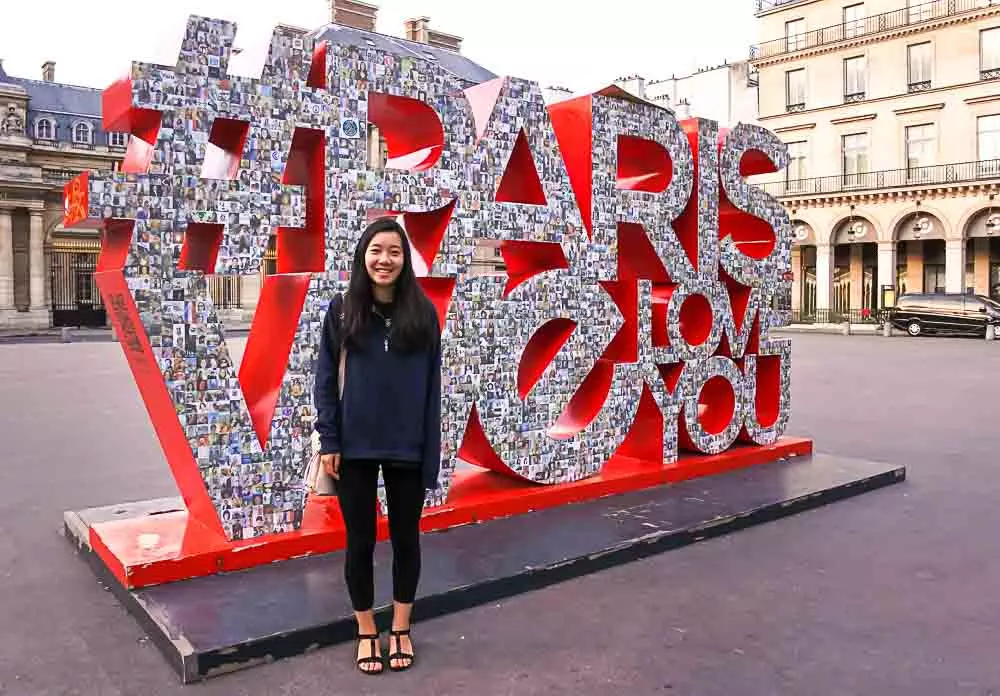Wondering what the weather in Paris, France is like each month?
This local weather information can be super-useful when you're planning a trip to the City of Light and want to decide the best season or month to travel.
Once you've decided when to visit Paris, knowing details such as the average as well as the extreme weather conditions that you might encounter while you're there will help you decide what to pack, where to stay (for example, should you book a hotel with no air conditioning for July?), and the best activities to add to your itinerary.
That's what this article is about. You'll find Paris weather by month and season, packing recommendations, and suggestions for weather-proof activities in case you encounter unexpected conditions or extreme temperatures.
You can even check the Paris weather for today plus the forecast for the coming week.
Article contents:
- Paris Weather Right Now & for This Week
- The Big Picture: What's Paris Weather Usually Like?
- Spring Weather in Paris
- Summer Weather in Paris
- Fall Weather in Paris
- Winter Weather in Paris
- Weather-Proof Paris Activities & Where to Stay
- Paris Weather by Month Source & Calculation Method
Last updated: February 3, 2025
Top photo: Eiffel Tower, on a sunny day with blue sky and white clouds, (c) Paris Discovery Guide
Paris Discovery Guide is a reader-supported publication. When you buy through our links, we may earn a commission at no additional cost for you. Thank you for your support!!!
Paris Weather Right Now & This Week
Wondering what the weather is like in Paris, France right now? Here is today's weather forecast for Paris in Fahrenheit and Celsius, as well as the 7-day Paris forecast for the coming week:
What's Paris Weather Usually Like? The Big Picture
Paris enjoys a generally temperate climate with four distinct seasons - but you'll find a surprising amount of overlap between each month along with lots of unpredictability throughout the year.
Occasionally you may experience the joy of a few spring-like days in the 50s and 60s (10°-20°C) during the winter months of December, January, and February.
Similarly, on occasional summer nights during June, July, and August can dip to the 40s (7° to 9°C) and feel like winter.
Although Paris temperatures typically hover in a moderate range, you may also be surprised by the possible weather extremes each month.
Minimum temperature readings can occasionally dip to 20°F (-7°C) or even a bit lower during January and February.
Paris summer months offer lovely warm weather with highs in the mid-70s (24° to 25°C) to lower 80s (27° to 28°C) - except when occasional heat waves send daily temperatures soaring to 100 degrees and beyond (40+°C).
On a scorching record-breaker day in July 2019, the official Orly Airport Weather Station recorded 107°F (42°C) and some local neighborhood stations within Paris reported a whopping 110°F (43°C)
What about rain? The climate of Paris is relatively dry, with average annual precipitation totaling just 25.6 inches (646 mm). Measurable precipitation falls on an average of 110 days each year, distributed more or less evenly across all months.
But there are exceptions. Sometimes so much rain falls at once (particularly during May and June) that the ground becomes super-saturated, causing the Seine River to overflow and flood the nearby Louvre, Orangerie, and Orsa museums.
In case you're wondering, May, June, and December have been the rainiest months during the past decade (October is a close second, thanks to one recent year with much heavier than usual rainfall), while April and July are the driest.
None of these extremes should discourage you from visiting Paris.
Paris Spring Weather by Month: March, April, May

The beauty of spring in Paris feels euphoric, with clear blue skies, increasingly warm temperatures, and flowers bursting into bloom throughout the city.
March weather in Paris often hovers on the chillier side, but you'll notice more warmth by April, and by the end of May, you'll be basking in the sunshine as you feel the first strong hints of summer heat.
Parisians relax and sip wine (or enjoy an entire meal) at outdoor terraces in front of cafes, sit on park benches to soak up sun, and pack away their heavy winter coats in favor of light-weight trenches (although perhaps with layers of sweaters underneath).
What's the most important thing to know about spring weather in Paris? "Erratic" and "unpredictable" define it (of course, you could argue that that's true in Paris year-round).
Daytime temperatures can soar to the upper 70s and 80s (26° to 32°C) with lots of sunshine, but also may hover in the low 40s (5°C) or lower. Rain and wind almost always accompanies these lows.
What to pack? For women, a water-resistant trench coat or jacket plus a sweater is a good idea, plus a couple of short-sleeved tops and maybe even a sleeveless one for those hot days in April and May.
You'll still see plenty of Parisians wearing their ankle boots, but boots of any sort are not really necessary at this point. What's important are comfortable, sturdy walking shoes - especially important if you hit an icy patch of sidewalk as you're heading back to your hotel after a later dinner.
For men, a waterproof jacket with a zip-out lining can be ideal, although a lighter weight rain jacket layered with a sweater also works well.
Precipitation (usually rain, but you might also see a bit of snow, sleet, and/or ice) can vary from a little to a lot. Sunny, dry weather can follow a week or two of gray, rainy days - but you never know when, or even if, this will happen.
Spring also marks a rapid transition from the short daylight hours of winter to the extremely long days of summer, with barely over 11 hours of daylight at the beginning of March to almost 16 hours by the end of May.
March Weather in Paris
10-year range of highest temperatures during March: 43°F to 78°F (6°C to 25°C)
10-year range of lowest temperatures: 3°F to 54° F (-5°C to 12°C)
10-year average of highest temperatures in March: 51°F to 59°F (10° to 15°C)
10-year average of lowest temperatures in March: 38°F to 43°F (3° to 6°C)
30-year record high temperature for this month: 78°F (25°C) in 2021
30-year record low temperature for this month: 15°F (-9°C) in 2005
Average precipitation for March during past 10 years: 2.2 inches (55 mm)
10-year annual range of monthly precipitation: 0.9 inch (23 mm) to 3.5 inches (88 mm)
Number of days with precipitation (10 year range): 5 - 23
Average hours of daylight: 12 hours, 0 minutes
Find out more about Paris Weather in March, plus what to pack & best things to do
April Weather in Paris
10-year range of highest temperatures during April: 38°F to 84°F (3°C to 29°C)
Range of lowest temperatures: 29°F to 58° F (-2°C to 15°C)
Average April high temperature - past 10 years: 58°F to 69°F (15° to 21°C)
Average April low temperature - past 10 years: 40°F to 48°F (4° to 9°C)
Record high temperature for April - past 30 years: 84°F (29°C) in 2018
Record low temperature for April - past 30 years: 29°F (-2°C) in 2021
Average precipitation for April during past 10 years: 1.5 inches (39 cm)
10-year annual range of monthly precipitation: 0.6 inch (16 mm) in three of the past 10 months to 2.9 inches (73 mm)
Number of days with precipitation (10 year range): 5 - 21
Average hours of daylight: 13 hours, 50 minutes
Find out more about Paris Weather in April, plus what to pack & best things to do
May Weather in Paris
Range of highest temperatures during May: 63°F to 89°F (17°C to 32°C)
Range of lowest temperatures during May: 34°F to 66° F (1°C to 19°C)
Average highest temperatures in May - past 10 years: 64°F to 72°F (18° to 22°C)
Average lowest temperatures in May - past 10 years: 33°F to 67°F (0° to 19°C)
Record high temperature for May - past 30 years: 89°F (32°C) in 2017
Record low temperature for May - past 30 years: 33°F (0°C) in 2019
Average precipitation for May: 2.6 inches (67 mm)
10-year annual range of monthly precipitation: 0.5 inch (14 mm) to 6 inches (152 mm)
Number of days with precipitation (10 year range): 5 - 23
Average hours of daylight: 15 hours, 20 minutes
Find out more about Paris Weather in May, plus what to pack & best things to do
Paris Summer Weather Each Month: June, July, August
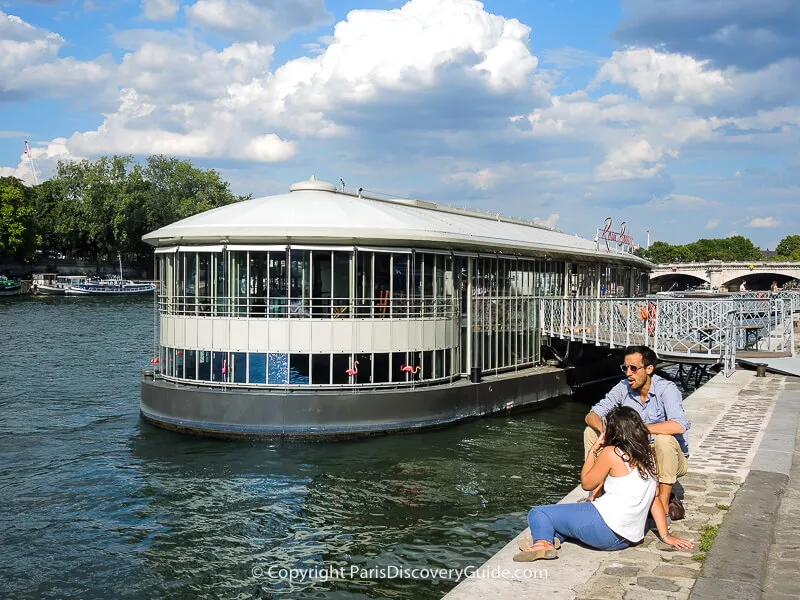
Summer weather in Paris can be glorious, with very long days and average daytime temperatures usually in the mid-to-upper 70s (24° to 26°C).
"Beaches" lined with chairs for lounging, wine bars, and in some areas, water sports pop up along the Seine River, while floating bars dot the river's edge. Paris parks attract visitors lots of free outdoor film and music festivals, plus grassy slopes for relaxing.
Summer is also a fantastic time of the year to visit Versailles Palace, Disneyland Paris, and Monet's famous gardens with lily ponds at Giver.
Sounds idyllic, right? Well, as always in Paris, you may also encounter a few days of extreme weather.
Heat waves lasting several days can occur when sirocco winds blow masses of hot air up from northwestern Africa, causing temperatures to soar to around 100° (38°C) or more and hitting an all-time high of 107° (42°C) in July, 2019 (although some local Paris weather stations reported temps as high as 110° (43°C).
Paris doesn't get these extreme heat waves every year - but during recent years, they have become more frequent. You should expect that one might happen during your visit - so plan accordingly.
See our tips for staying cool during a Paris summer heat wave
At other times, cool fronts move in from the Atlantic, bringing a few days of rain and chilly temperatures in the low 40s to mid-50s (5° to 13°C).
Pack light-weight clothing to stay comfortable in the (sometimes extreme) heat, but do add a sweater or two, or a light jacket. Sandals can be tempting but since sidewalks are not reliably free of dog poop, you may feel happier in closed-toe shoes.
Although both June and July usually have close to the same amount rainfall on average as August (which typically has only 7 days with precipitation), June in particular sometimes gets lots more from torrential rains.
When this happens, watch out! The rain quickly saturates the ground and causes the Seine River to rise enough to overflow its banks, triggering river-side museums (Louvre, Orangerie, Orsa) to close as they protect their art.
Despite all of this, summer is still a fantastic time to visit Paris - but if you're planning to rent an apartment for your visit, don't forget about the possibility of uncomfortably hot days and even nights.
Paris Travel Tip: Most Paris hotels with 3 stars or more offer air conditioning, but if you're planning to rent an apartment for your visit during summer months, consider choosing one with a/c, especially if you will be here during July and August.
And keep in mind that very few 2-star hotels and almost no 1-star hotels have air conditioning.
June Weather in Paris
10-year range of highest temperatures during June: 56°F to 99°F (14°C to 37°C)
10-year range of lowest temperatures during June: 43°F to 70° F (6°C to 70°C)
10-year average of highest temperatures in June: 71°F to 82°F (2° to 28°C)
10-year average of lowest temperatures in June: 55°F to 60°F (13° to 16°C)
Record high temperature for this month for past 30 years: 99°F (37°C) in 2017
Record low temperature for this month for past 30 years: 38°F (3°C) in 2006
Average precipitation for June during past 10 years: 2.7 inches (68 mm)
10-year annual range of monthly precipitation: 0.2 inch (4 cm) to 5.5 inches (141 mm)
Number of days with precipitation (10 year range): 3-17
Average hours of daylight: 16 hours, 5 minutes
Find out more about Paris Weather in June, plus what to pack & best things to do
July Weather in Paris
10-year range of highest daily temperatures during July: 64°F to 107°F (18°C to 42°C)
10-year range of lowest daily temperatures during July: 48°F to 76° F (9°C to 24°C)
10-year average of highest temperatures in July: 79°F to 85°F (26°C to 29°C)
10-year average of highest temperatures in July: 59°F to 64°F (15°C to 18°C)
Record high temperature for past 30 years: 107°F (42°C) in 2019
Record low temperature for past 30 years: 47°F (8°C) in 2008
Average precipitation for July: 1.3 inches (33 mm)
Range of July precipitation for the past 10 years: 0.7 inch (18 mm) to 2.7 inches (69 cm)
Number of days with precipitation during past 10 years: 2-13
Average hours of daylight: 15 hours, 40 minutes
Find out more about Paris Weather in July, plus what to pack & best things to do
August Weather in Paris
10-year range of highest daily temperatures during August: 58°F to 102°F (15°C to 39°C)
10-year range of lowest daily temperatures: 45°F to 74° F (7°C to 23°C)
10-year average of highest temperatures in August: 75°F to 84°F (24°C to 29°C)
10-year average of lowest temperatures in August: 58°F to 64°F (15°C to 18°C)
Record high temperature for this month for past 30 years: 104°F (40°C) in 2003
Record low temperature for this month for past 30 years: 43°F (6°C) in 2014
Average precipitation for August: 2.3 inches (59 mm)
Range of August precipitation for the past 10 years: 0.7 inch (18 mm) to 3.2 inches (81 mm)
Number of days with precipitation during past 10 years: 7-18
Average hours of daylight: 14 hours, 20 minutes
Find out more about Paris Weather in August, plus what to pack & best things to do
Paris Fall Weather by Month: September, October, November
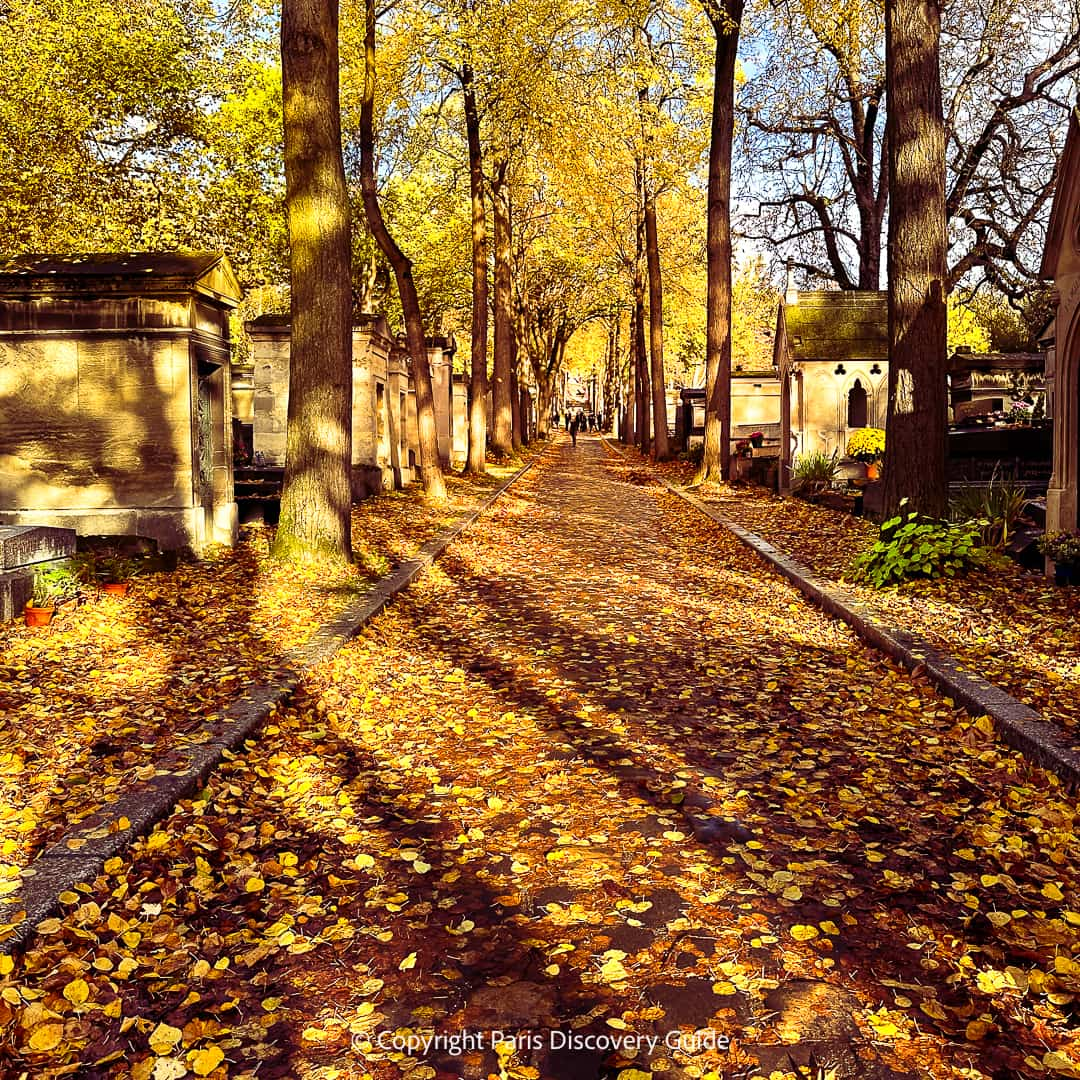
Paris typically enjoys fantastic autumn weather, without the extremes of other seasons, and by late September, you'll even see tinges of fall foliage color as leaves slowly turn golden.
Colors usually peak in October, but continue to be lovely but more muted in November.
Although November weather is noticeably cooler, rainier, and has far fewer hours of daylight than September or even October, all three months usually experience a number of balmy days.
In fact, daytime temperatures during Paris weather in September can soar into the 90s (33+°C), although usually only for a few hours during a day or two at a time - so no prolonged heat spells like you might experience during the summer months.
When you're packing for your autumn trip, make sure to include something cool enough to wear on hot days that can serve as an extra layer during crisp Paris weather in fall. You'll also need a jacket when you visit Paris in the fall, especially during November, plus a sweater or two to layer underneath when needed.
Paris usually attracts lots of tourists as well as business visitors during September and October, but by November, crowds begin to thin out as the days grow shorter and temperatures drop, especially during the second half of the month.
But that's when Christmas lights start to sparkle all over the city and Christmas markets begin to open, so you may not notice the chill!
Will you see snow in Paris during the fall? Maybe - usually during the latter half of November, if at all. The snow melts quickly, if it stays on the ground long for more than a few minutes, but seeing the snowflakes fall always feels magical.
Weather in Paris in September
Here's the range of daily highs and lows throughout September during the past 10 years:
- Range of monthly highest temperatures during September: 56°F to 96°F (13°C to 35°C)
- Range of monthly lowest temperatures during September: 39°F to 69° F (4°C to 21°C)
Here's average daily highs and lows throughout September during the past 10 years:
- Average September highest temperature for past 10 years: 67°F to 83°F (19°C to 24°C)
- Average September lowest temperature for past 10 years: 50°F to 60°F (10°C to 15°C)
Here are the record-breaking extreme high and low temperatures during the past 30 years:
- Highest September temperature (1991-present): 96°F (35°C) in 2023 (worth noting: the previous high of 94°F / 34°C was set just two years earlier in 2021)
- Lowest September temperature (1991-present): 38°F (3°C) in 2012
Want to know about how much rain to expect? Here's the average for September, and the range and average number of days with rain for the past decade:
- Average precipitation for September: 2.2 inches (55 mm)
- Range of September precipitation for the past 10 years: 0.4 inch (1 mm) to 4.7 inches (11.9 mm)
- Number of days with precipitation during past 10 years: 7 - 23
And last but not least, Paris gets an average of 12 hours and 30 minutes of daylight during September.
Find out more about Paris Weather in September, plus what to pack & best things to do
Paris Weather in October
Range of daily high temperatures in October during past 10 years: 43°F to 84°F (14°C to 29°C)
Range of daily low temperatures in October during past 10 years: 34°F to 64° F (1°C to 18°C)
10-year average of highest temperatures in October: 59°F (15°C) to 68°F (20°C)
10-year average of lowest temperatures: 45°F (7°C) to 53°F (12°C)
Record high temperature during October for past 30 years: 84°F (29°C) in 2023
Record low temperature for past 30 years: 27°F (-3°C) in 1997
Average precipitation for October during past 10 years: 2.6 inches (67 mm)
10-year annual range of monthly precipitation: 0.9 inch (23 mm) to 6.7 inches (169 mm)
Number of days with precipitation (10 year range): 10 - 25
Average hours of daylight: 10 hours, 45 minutes
Find out more about Paris Weather in October, plus what to pack & best things to do
Weather in Paris in November
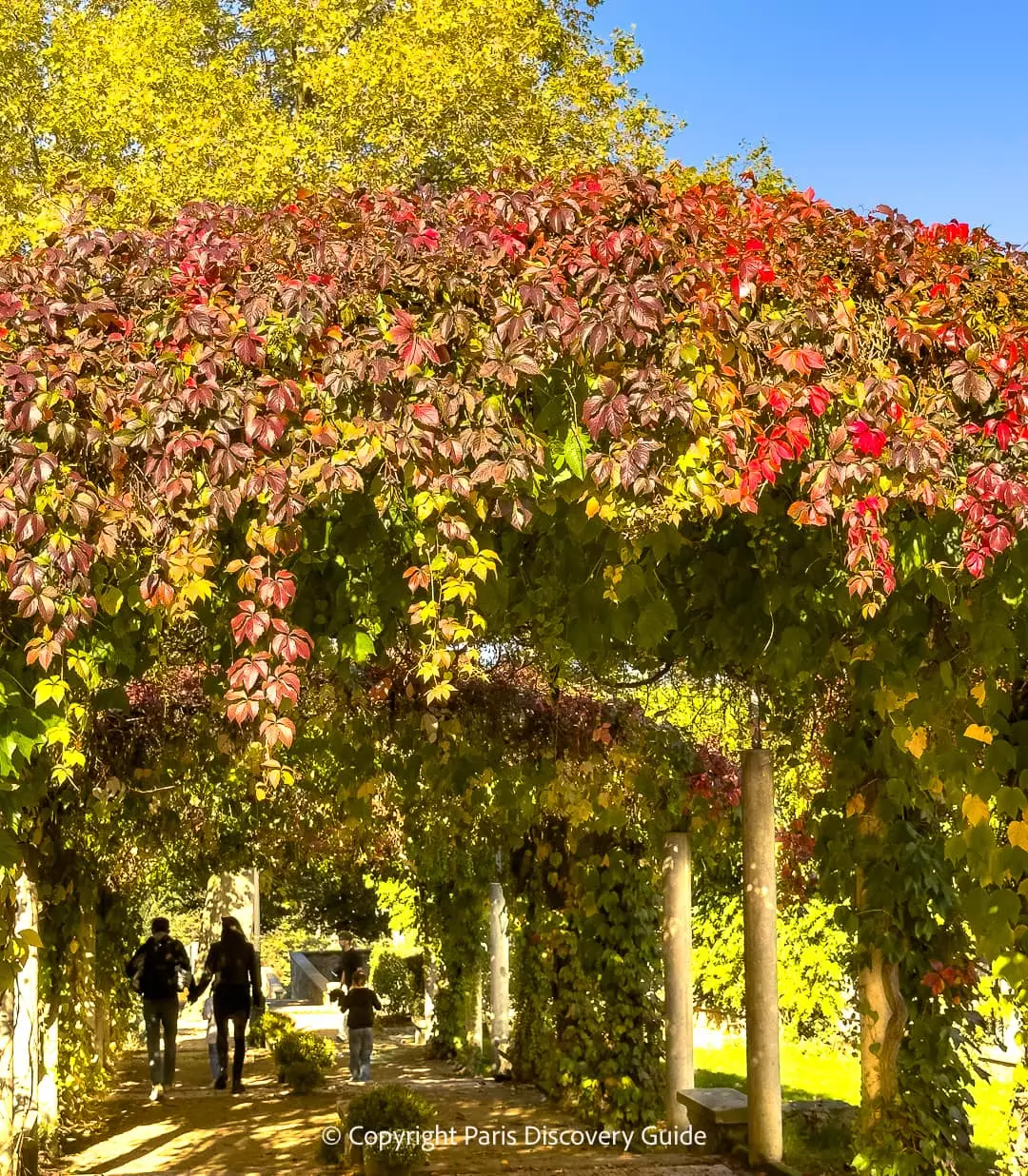
Range of daily high temperatures during November: 35°F to 71°F (1°C to 22°C)
Range of daily low temperatures during November: 24°F to 59° F (-5°C to 15°C)
10-year range of average highest temperatures in November: 50°F (10°C) to 57°F (14°C)
10-year range of average lowest temperatures in November: 39°F (4°C) to 46°F (8°C)
Record high temperature for this month (1991-present): 71°F (22°C) in 2015
Record low temperature for this month (1991-present): 17°F (-8°C) in 1998
Average precipitation for November during past 10 years: 2.4 inches (62 mm)
10-year annual range of monthly precipitation: 0.6 inch (15 mm) to 3.8 inches (98 mm)
Number of days with precipitation (10 year range): 15-25, which means you'll probably experience some rain on at least half and maybe most days during November
Average hours of daylight: 9 hours, 5 minutes
Find out more about Paris Weather in November, plus what to pack & best things to do
Paris Winter Weather by Month: December, January, February
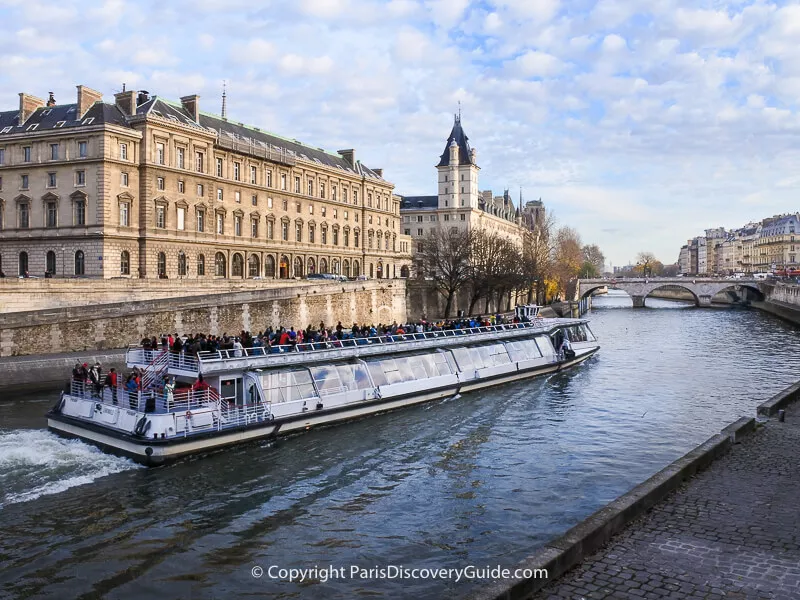
Travel advice often characterizes winter in Paris as quite cold and gray, but that's not totally true. Sure, some days fit that description, but if you live in a cold climate such as the northern U.S., Canada, or Northern Europe, you might be more inclined to call it "chilly."
Even the grayest days may offer periods when the sun peaks through the clouds. And if you're lucky, you may even experience several or more days of brilliant sun.
Average high temperatures for all three months hover in the upper 40s (8°C) to the mid-50s (12°C), but each month usually includes a few (or more) days as high as the 60s (17° to 20°C).
February even experienced a high of 69° (21°C) a few years ago. You'll certainly need to bring a medium or heavy-weight coat or jacket, but make sure you also pack a sweater or two, and be prepared to dress in layers - just in case there's a repeat of that day in the upper 60s (teens).
Although all three winter months have experienced 24 or more days with precipitation during the past decade, the rain often comes in the form of brief showers and drizzle. Even when it falls steadily, rain seldom continues all day (even though you may feel like it does).
For those wet days, bring a couple of pairs of waterproof or water-resistant ankle boots or walking shoes if you already have them so that if one pair gets soaked, you'll have another dry pair to wear while the first pair dries. However, if you live in an area where you have no need for waterproof footwear, you really don't need to buy any for your trip - just stay on pavement (easy to do in Paris) and avoid stepping in puddles.
Will you see snow during the winter in Paris? Maybe, but usually not much - maybe a few days with a dusting and perhaps a couple with an accumulation of 1-2 inches (2.5 to 5 cm). Most of the time, the snow melts quickly as the temperature rises. Ice fog - yes, that's literally frozen fog - is more common than snow.
Are Paris winters dark and dreary? Not really. Brilliant lights, holiday decorations, and Christmas markets keep the city bright and festive between mid-November and early January.
Ice skating rinks pop up in a few locations (check our Christmas in Paris article to find out where, as the locations vary somewhat every year). The big semi-annual sales start in early January and usually continue into February. Museums host some of their best exhibitions during winter months.
And by late February, you can spot the earliest magnolia and cherry blossoms as well as patches of daffodils in Paris parks. And actually, in many of the city's numerous green spaces, you'll find a few things with small blooms during December and January if you look closely enough.
Paris Weather in December
Range of daily high temperatures during December: 27°F to 61°F (-3°C to 16°C)
Range of daily low temperatures during December: 21°F to 57° F (-6°C to 14°C)
10-year average of highest temperatures in December: 46°F to 53° F (7°C to 12°C)
10-year average of lowest temperatures in December: 34°F to 44° F (1°C to 7°C)
Record high temperature for past 30 years: 62°F (17°C) in 2000
Record low temperature for past 30 years: 14°F (-10°C) in 1996
Average precipitation for December during past 10 years: 2.7 inches (68 mm)
10-year annual range of monthly precipitation: 0.6 inch (16 mm) to 4.8 inches (122 mm)
Number of days with precipitation (10 year range): 7-25
Average hours of daylight: 8 hours, 20 minutes
Find out more about Paris Weather in December, plus what to pack
Weather in Paris in January
Range of daily high temperatures during January: 28°F to 59°F (-2°C to 15°C)
Range of daily low temperatures during January: 18°F to 53° F (-8°C to 11°C)
10-year average of highest temperatures in January: 40°F to 50° F (5°C to 10°C)
10-year average of lowest temperatures in January: 35°F to 42° F (2°C to 5°C)
Record high temperature for past 30 years: 62°F (17°C) in 2003
Record low temperature for past 30 years: 8°F (-13°C) in 2010
Average precipitation for January during past 10 years: 2.0 inches (52 mm)
10-year annual range of monthly precipitation: 0.7 inch (18 mm) to 4.5 inches (114 mm)
Number of days with precipitation (10 year range): 12-24
Average hours of daylight: 8 hours, 50 minutes
February Weather in Paris
Range of daily high temperatures during February: 28°F to 69°F (-2°C to 21°C)
Range of daily low temperatures during February: 17°F to 54° F (-9°C to 12°C)
10-year average of highest temperatures in January: 40°F to 55° F (5°C to 13°C)
10-year average of lowest temperatures in January: 29°F to 45° F (-1°C to 7°C)
Record high temperature for past 30 years: 69°F (21°C) in 2019
Record low temperature for past 30 years: 10°F (-12°C) in 1991
Average precipitation for February during past 10 years: 1.8 inches (45 mm)
10-year annual range of monthly precipitation: 0.1 inch (2 mm) to 2.6 inches (66 mm)
Number of days with precipitation (10 year range): 3-21 (Interesting to note: February 2023 experienced the smallest amount of rain during the past 10 years - a barely measurable one-tenth of an inch / 2 mm but it fell over the course of 3 days - so literally, just a few drops each day)
Average hours of daylight: 10 hours, 10 minutes
Find out more about Paris Weather in February, plus what to pack & best things to do
Weather-Proof Paris Attractions, Things to Do, & Where to Stay
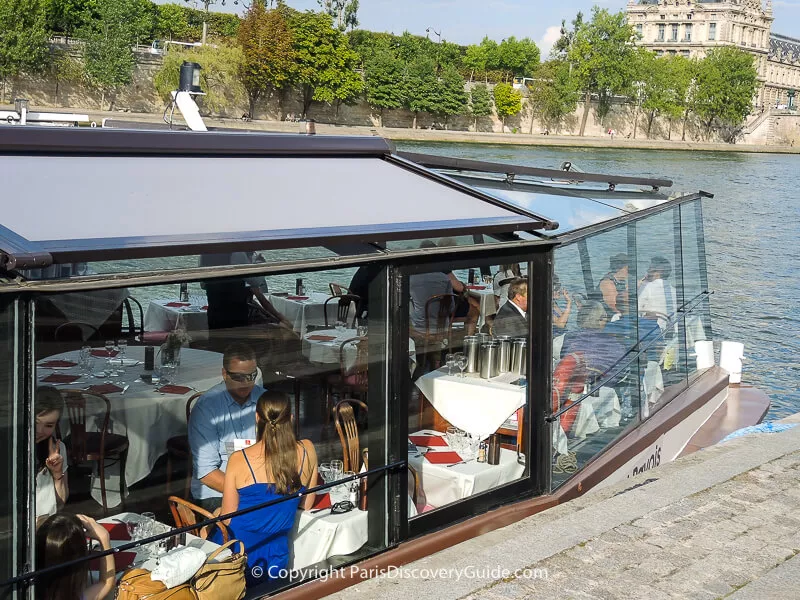
These activities will insulate you from the weather, whether it's too rainy, too cold, or too hot and steamy:
- Seine River Dinner Cruise - Savor a gourmet meal in a climate-controlled glass-enclosed boat while seeing famous sights along the river
- Hop-On Hop-Off Sightseeing Tour Bus - Stay warm and dry while you ride on the covered upper deck or enclosed lower deck
- Cooking Classes - Here are our three favorite small-group experiences: French Croissant Baking Class - French Macaron Culinary Class - Market Visit & Cooking Class with a Parisian Chef
- Moulin Rouge - Enjoy an evening of entertainment and champagne in this famous Paris cabaret - or choose the gourmet dinner option
- Paris Museums - You won't care what the weather outside is like when you use a Paris Museum pass for free admission to the Louvre, Orsa, Versailles, and almost 60 other famous Paris museums and attractions
- Paris's Covered Passages - Explore the eclectic boutiques (which range from luxury to quirky), artisan workshops, and bistros in these hidden 19th century gems - one of my personal favorite activities for less than ideal weather days
Find Out More About Weather in Paris
Paris Weather & Packing Tips by Month
Jan - Feb - March - April - May - June - July - Aug - Sept - Oct - Nov - Dec
Related Articles
- What to Expect in Paris Each Season - Consider the pros and cons for each season
- When's the Best Time to Visit Paris? - When to save on hotels, avoid crowds, enjoy great weather, and more
- Paris Weather Each Month - Compare months to find the best one for your visit
More Fun Things to Do & See in Paris
Compare Hotel Rates for Different Months
Want to see how much Paris hotel rates vary by month? Use this hotel booking map to see current rates across the city, and then enter the travel dates you're considering to see how they might vary.
Pro tip: Hotel rates usually trend higher during May, June, September, October, and about a 2-week period including Christmas and New Year. Expect for that 2-week period, rates from November through mid-March tend to be at their lowest.
Booking.comCheck out the newest Paris hotels
Is the Weather Information in this Article Up to Date & Accurate?
Yes to both.
We use Paris data from the official Orly Airport Weather Monitoring Station.
We calculate these measurements for the most recent 10 years:
- Temperature ranges (high and low) and averages for each month
- Precipitation ranges and averages for each month
- Ranges for the number of days with precipitation
The record high and low temperatures for each month reflect the past 30 years.
We update on a rolling basis throughout the year after the end of each month so that you'll always see the most current accurate information for the previous 10 or 30 years.
If you're curious, you can find out more details about our methodology in the following section. But if you're not, skip it (truthfully, it's kind of boring), and find out more about Paris weather for the months when you might be there:
Jan - Feb - March - April - May - June - July - Aug - Sept - Oct - Nov - Dec
Why We Wrote this Article about Paris Weather, Plus Our Data Sources and Methodology
Let's start with the "why."
If you're looking for location-specific weather information in order to figure out the best time to travel to a destination, what to pack, and the best things to do once you're there, you probably want the weather data to be current, right?
We wanted accurate information that reflected current weather trends including temperature averages and ranges by month for the past 10 years including the previous year.
But that's not what we found.
When we searched for details about Paris weather for a specific month, what we got instead were generalities such as "May weather in Paris is glorious, with almost no rain!" or "May's temperature averages 51° - 68°, with no indication of what year that occurred, or the daily range of high and low temperatures.
If you know that May's average low of 51° includes daily lows ranging from 34° to 66° and daily highs ranging from 63° to 89°, you may pack differently than you would if you look at only the monthly average.
And, seeing data for 10 years - enough to count as a short-term trend - provides more benefit than looking at just one year's data, since weather conditions aren't exactly the same year after year.
We realized that other Paris travelers might want this information too, so we turned into "weather data nerds" and used official measurements from NOAA taken at the Orly Airport weather station to calculate information for these periods:
- Range and average of highest and lowest temperatures, and average rainfall by month: Past 10 years
- Record high and low temperatures: 1991 - present
We update this article and the associated monthly article each month with the latest data after then end of each month to make sure you (and we) have the most recent and reliable up-to-date information when planning our trips to Paris - you can find the date of the most recent update near the top of this page.
We thank Meteostat for making the raw data from NOAA/Paris Orly Airport freely available.
Other Paris Weather Resources
For current Paris weather predictions for each day and month, Meteoblue is an excellent French source.
Best historical weather data sources: Meteostat, The Weather Channel, Weather Spark, Weather and Climate, and Time and Date.
Please note that a number of the historical weather sources appear to not be up to date.
More Articles for Paris Visitors
- Why Visit Paris? - So many reasons!
- Best Paris Neighborhoods to Stay in for First-Time Visitors
- What to Do on Your First Day in Paris (when you're still jet-lagged)
- Should You Bring Power Adapters or a Power Converter?
- Recommended Paris Guide Books - Find the best guidebooks for planning your trip to Paris - Rick Steves and more!




















